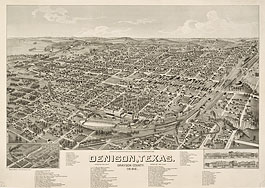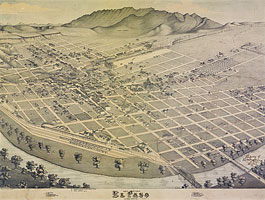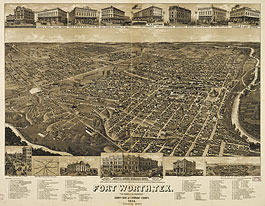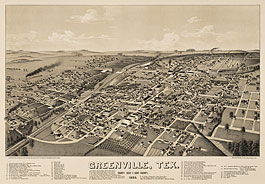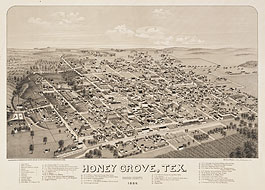Denison in 1886
Henry Wellge was an experienced bird’s-eye-view artist by the time he began his Texas tour in 1885. With more than fifty prints to his credit, he produced an India-ink drawing of Denison, more or less the northern entrance into Texas, that one correspondent claimed “shows at a glance the character of the country, the location and development of our city.” Denison was a city literally built by the railroad… [More]
El Paso in 1886
Throughout its history prior to 1881, El Paso-area business had been dominated by its location on the north-south Camino Real that connected Mexico City with Chihuahua and Santa Fe. With the arrival of the Southern Pacific Railroad in May 1881, however, the city got a direct rail connection with the West Coast, and when the Southern Pacific connected with the Texas and Pacific at Sierra Blanca the following December… [More]
Fort Worth in 1886
The arrival of the railroad ushered in an era of astonishing growth for Fort Worth as migrants from the devastated South continued to swell the population and small, community factories and mills yielded to larger businesses. Newly dubbed “Queen City of the Prairies,” Fort Worth supplied a regional market via the growing transportation network. More smokestacks are evident in Henry Wellge’s 1886 view, which the editor of the Fort… [More]
Greenville in 1886
Wellge continued his tour of the North Texas cotton-farming country with a visit to Greenville late in 1885. Prior to the arrival of the railroads, Greenville had been what one historian called an “inland island,” thirty miles from a railroad in any direction and a modest producer of traditional agricultural crops. But an increase in the number of slaves before the Civil War and the arrival of the railroads… [More]
Honey Grove in 1886
Traveling eastward, probably on the Texas and Pacific Railroad, Wellge continued his tour of North Texas with a visit to Honey Grove, a little more than forty miles from Denison. The city got its name from a nearby grove of trees, where the early settlers found an apiary. The arrival of the T&P in 1873 had turned the village of about 300 persons into a small, regional center with… [More]











